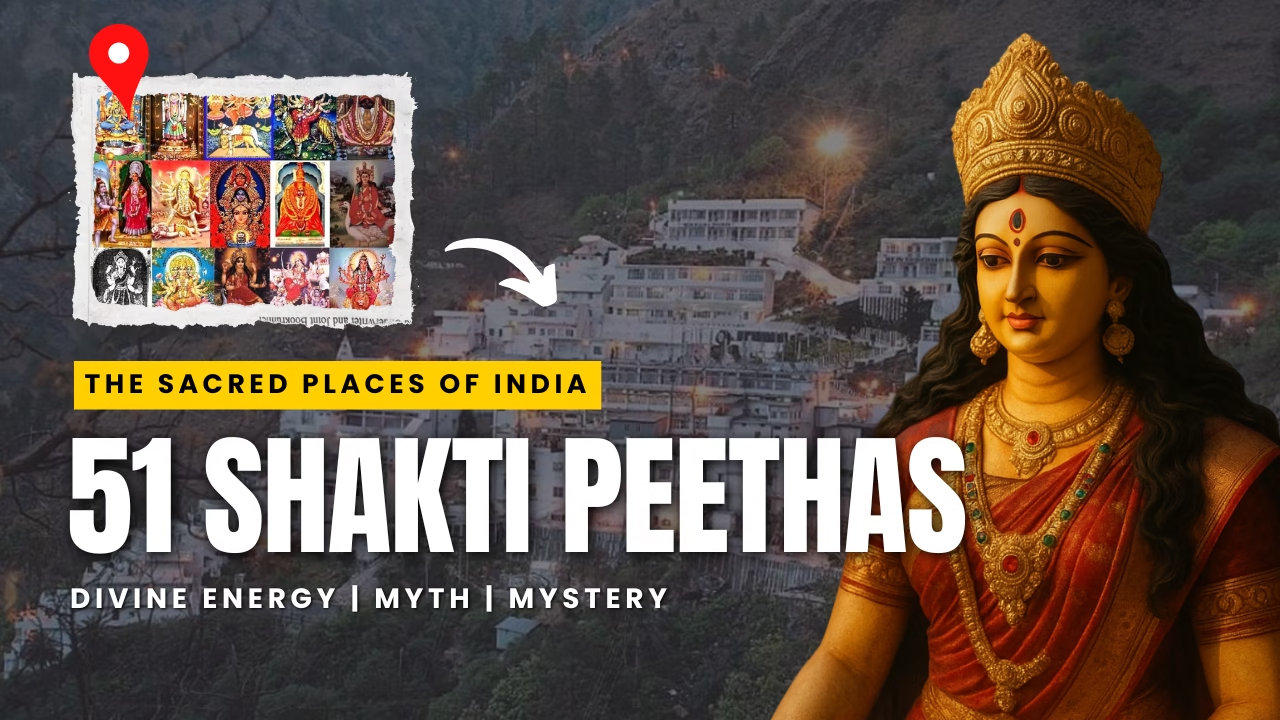All across the Indian subcontinent, there are special places where people believe the divine feminine energy — called Shakti — lives. These are known as the Shakti Peethas, sacred spots filled with powerful energy and deep spiritual meaning.
According to Hindu belief, these are not just ordinary temples. Each one marks the exact place where a part of Goddess Sati’s body is said to have fallen to Earth after her death. That’s why these temples are not just destinations — they are gateways to ancient stories, devotion, and spiritual power.
From the snowy mountains of Himachal to the peaceful shores of Tamil Nadu, from hidden caves in Pakistan to the crowded lanes of West Bengal, these holy places go beyond borders and time. They attract pilgrims, spiritual seekers, and history lovers from all over the world.
In this article, we’ll take you on a journey through the legends, meanings, and spiritual energy of the Shakti Peethas — places where the Goddess still lives in power and grace.
Table of Contents
The Legend Behind the Shakti Peethas
The story of the Shakti Peethas comes from one of the most emotional and powerful legends in Hindu mythology.
Goddess Sati, who was the first wife of Lord Shiva, was the daughter of King Daksha. When King Daksha held a big yajna (a sacred fire ritual), he did not invite Shiva because he didn’t approve of Sati’s marriage to him.
Sati felt deeply hurt and insulted by her father’s behavior. Out of pain and anger, she jumped into the fire and gave up her life.
When Shiva found out, he was heartbroken and furious. He picked up Sati’s lifeless body and began performing the Tandava, a powerful dance of destruction that shook the universe.
To calm Shiva and save the world, Lord Vishnu used his Sudarshan Chakra (divine discus) to cut Sati’s body into pieces. These pieces fell at different places on Earth, and each place where a part fell became a Shakti Peeth — a sacred site filled with the divine energy of the Goddess.
Today, these places are worshipped as powerful temples where Shakti (divine feminine) is present. Every Shakti Peeth also has a nearby shrine to Bhairava (a form of Shiva), showing the balance between feminine and masculine energy — the two forces that keep the universe in harmony.
How Many Shakti Peethas Exist?
When it comes to the number of Shakti Peethas, different scriptures and traditions mention varying counts — but the most commonly accepted number is 51 or 52. These sacred sites are found across India and neighbouring countries, each believed to hold a piece of Goddess Sati’s divine presence.
Some ancient texts also speak of 108 Shakti Peethas, but the core ones — recognized in major scriptures like the Shiva Purana, Devi Bhagavata Purana, and Tantra Chudamani — are the 51-52 Peethas that form the spiritual backbone of Shaktism.
The Four Adi Shakti Peethas
Among all, there are four most powerful Shakti Peethas, often referred to as the Adi Shakti Peethas. These are considered the primary seats of the Goddess’s energy and are major centers of pilgrimage.
- Kamakhya Devi (Assam) – Yoni (womb), symbol of creation
- Tarapith (West Bengal) – Third eye, linked to tantric worship
- Kalighat (Kolkata, West Bengal) – Right toe, symbol of humility
- Bhairavi Devi (Himachal Pradesh) – Tongue or head, representing speech and knowledge
These temples are not just important spiritually but also culturally, as they blend myth, devotion, and local traditions in a powerful way.
The Ashta Dasha Shakti Peethas (18 Peethas)
In South Indian texts, especially those followed in Andhra Pradesh, Telangana, and Tamil Nadu, 18 Shakti Peethas hold special significance. These are known as the Ashta Dasha Shakti Peethas and are mentioned in the Ashta Dasha Shakti Peetha Stotram composed by Adi Shankaracharya.
Some of these include:
- Sri Mahalakshmi (Kolhapur, Maharashtra)
- Chamundeshwari (Mysuru, Karnataka)
- Mookambika (Kollur, Karnataka)
- Sundari Devi (Jwalaji, Himachal Pradesh)
- Madhaveshwari (Prayagraj, Uttar Pradesh)
These 18 Peethas are particularly revered during Navratri, when devotees perform parikramas (pilgrimages) or chant their names for blessings, protection, and spiritual growth.
Did You Know?
Some Shakti Peethas are located outside India — in Pakistan, Bangladesh, Nepal, and Sri Lanka, making this a rare religious network that transcends modern-day borders.
| S.No. | Location (State/Country) | Part of Sati | Shakti (Devi) | Bhairava (Shiva) |
|---|---|---|---|---|
| 1 | Kamakhya, Assam | Yoni | Kamakhya | - |
| 2 | Kalighat, West Bengal | Right Toes | Dakshina Kali | Nakuleshwar |
| 3 | Jwalaji, Himachal Pradesh | Tongue | Siddhida | Unmatta Bhairava |
| 4 | Ambaji, Gujarat | Heart | Amba | Batuk Bhairava |
| 5 | Hinglaj, Balochistan, Pakistan | Bramharandhra (Head) | Hinglaj Mata | Bhimalochana |
| 6 | Kanyakumari, Tamil Nadu | Back and Spine | Sravani | Nimish |
| 7 | Ujjain, Madhya Pradesh | Elbow/Upper Lip (debated) | Avanti | Lambakarna |
| 8 | Amarkantak, MP | Right Buttock | Narmada | Bhadrasen |
| 9 | Nainativu, Sri Lanka | Anklets | Nagapooshani | Nayinaar |
| 10 | Bharatpur, Rajasthan | Left Leg | Ambika | Amriteshwar |
| 11 | Sri Shail, Bangladesh | Neck | Mahalakshmi | Sambaranand |
| 12 | Prayagraj, Uttar Pradesh | Fingers | Lalita | Benimadhav |
| 13 | Janasthaan, Maharashtra | Chin | Bhramari | Vikritaksh |
| 14 | Hooghly, West Bengal | Right Shoulder | Kumari | Bhairav |
| 15 | Tripura Sundari, Udaipur, Tripura | Right Foot | Tripurasundari | Tripuresh |
| 16 | Border of Nepal and India | Left Shoulder | Uma | Mahodara |
| 17 | Birbhum, West Bengal | Neck Bone | Nandini | Nandikeshwar |
| 18 | Shivaharkaray, Pakistan | Third Eye | Mahishasuramardini | Krodish |
| 19 | Kurukshetra, Haryana | Right Ankle | Savitri/Bhadra Kali | Sthanu |
| 20 | Vrindavan, Uttar Pradesh | Hair | Uma | Bhuteshwar |
| 21 | Mysore, Karnataka | Hair | Chamundeshwari | Bheeshan Bhairava |
| 22 | Jalandhar, Punjab | Left Breast | Tripurmalini | Bhishan |
| 23 | Jajpur, Odisha | Navel | Biraja | Varaha |
| 24 | Chandranath, Bangladesh | Right Arm | Bhavani | Chandrashekhara |
| 25 | Bahula, West Bengal | Left Arm | Bahula | Bhiruk |
| 26 | Attahas, West Bengal | Lower Lip | Phullara | Vishvesh |
| 27 | Vaidyanath, Jharkhand | Ears | Jaya Durga | Vaidyanath |
| 28 | Gandaki, Nepal | Cheek | Gandaki Chandi | Chakrapani |
| 29 | Murshidabad, West Bengal | Crown | Vimla/Kiriteshwari | Samvarta |
| 30 | Mansarovar, Tibet | Right Hand | Dakshayani/ Manasa | Amar |
| 31 | Manikarnika, Varanasi | Earrings | Vishalakshi | Kalbhairava |
| 32 | Suchindram, Tamil Nadu | Upper teeth | Narayani/Kanya Kumari/ Bhagavathy Amman | Sangharor Samhara |
| 33 | Satna, MP | Necklace | Shivani | Chanda |
| 34 | Guhyeshwari, Kathmandu, Nepal | Hips | Mahashira | Kapali |
| 35 | Bhavanipur, Bangladesh | Anklet/ribs of left chest/right eye (debated) | Aparna | Vaman |
| 36 | Bakreshwar, West Bengal | Portion between eyebrows | Mahishmardini | Vakranath |
| 37 | Danteshwari, Chhattisgarh | Teeth | Danteshwari | Kapalbhairava |
| 38 | Panchsagar, Uttar Pradesh | Lower teeth | Varahi | Maharudra |
| 39 | Amarnath, Jammu and Kashmir | Throat | Mahamaya | Trisandhyasvar |
| 40 | Nartiang Meghalaya | Left Thigh | Jayanti | Kamadishwar |
| 41 | Khulna, Bangladesh | Palm | Jeshoreshwari | Chanda |
| 42 | Amarkantak, Madhya Pradesh | Left Buttock | Kalmadhava | Astiananda |
| 43 | Birbhum, West Bengal | Bones | Devgarbha | Ruru |
| 44 | Jalpaiguri, West Bengal | Left Leg | Bhraamri | Iswar |
| 45 | Pushkar, Rajasthan | Wrist/Bracelet | Gayatri/Chamunda Devi | Sharvananda |
| 46 | Junagarh, Gujarat | Stomach | Chandrabagha | Vakratund |
| 47 | Rajamahendravaram, Andhra Pradesh | Left Cheek | Vishweshwari/ Rakini/ Viswamatuka | Vatsnabh/Dandapani |
| 48 | Srisailam, Andhra Pradesh | Right Anklet | Bhramaramba Devi/ SriSundari | Sundarananda |
| 49 | Shikarpur, Bangladesh | Nose | Sunanda | Traimbak |
| 50 | Ujaani, West Bengal | Right Wrist | Mangal Chandika | Kapilambar |
| 51 | Medinipur, West Bengal | Left Ankle | Kapalini/Kali | Sarvananda |
Key Shakti Peethas: Stories & Significance
While all Shakti Peethas are considered sacred, some have gained special prominence due to their legends, rituals, and the sheer power devotees experience when visiting. Below are a few of the most revered Peethas and the fascinating stories behind them.
Kamakhya Temple – Assam
Part Fallen: Yoni (Womb)
Shakti: Kamakhya Devi
Bhairava: Umananda
Situated atop Nilachal Hill in Guwahati, Kamakhya is among the most powerful and tantric Shakti Peethas. It represents the feminine energy of creation, as it’s believed to be where the womb or yoni of Goddess Sati fell.
What makes this temple unique is that there is no idol, only a stone structure shaped like a yoni that is naturally bathed by a spring. Each year during the Ambubachi Mela, the temple is closed for 3 days to mark the Goddess’s menstruation — a celebration of womanhood and fertility.
📌 Spiritual Highlight: One of the rare temples that openly celebrates the divine feminine’s generative power.
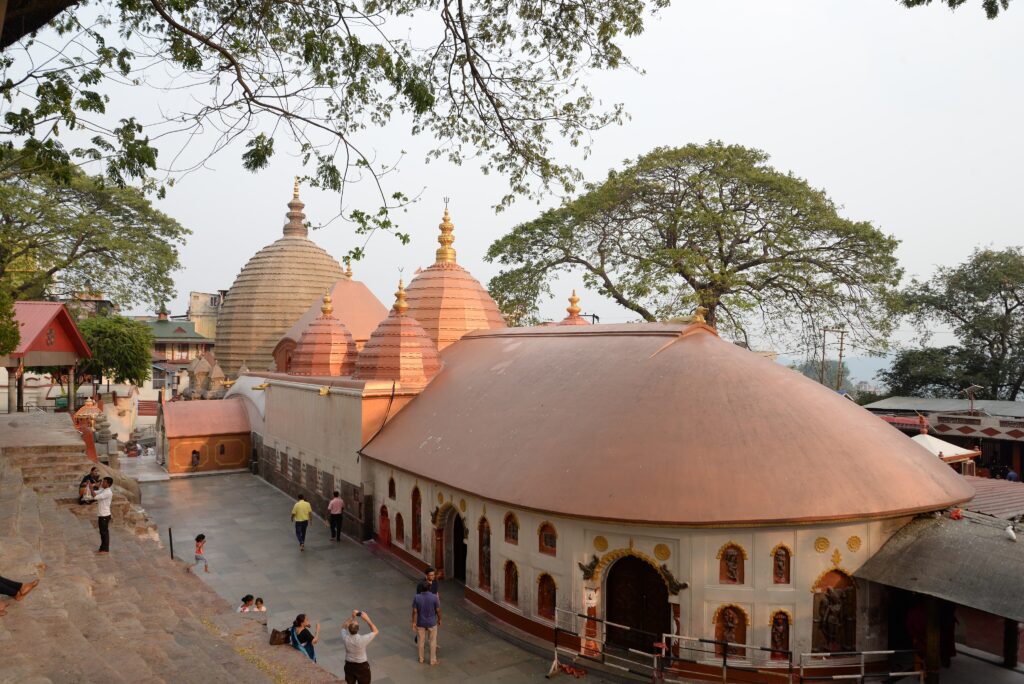
Image Credit: Devkmaravi, CC BY-SA 4.0 via Wikimedia Commons
https://commons.wikimedia.org/wiki/File:Kamakhya_Temple_-_DEV_8829.jpg
Know more about the Kamakhya Devi Temple – “Kamakhya Devi Temple – The Mystical Womb of Creation“
Kalighat Temple – Kolkata, West Bengal
Part Fallen: Right Toes
Shakti: Kalika
Bhairava: Nakuleshwar
Located in the heart of Kolkata, Kalighat is one of the most accessible and visited Shakti Peethas in India. The temple, built near the sacred Adi Ganga river, is known for its fierce yet protective form of the Goddess.
Kalika is worshipped here as a dark, powerful mother figure with a long protruding tongue, symbolizing the moment she calmed down after her cosmic rage.
📌 Spiritual Highlight: A symbol of raw divine power, feminine strength, and maternal protection.
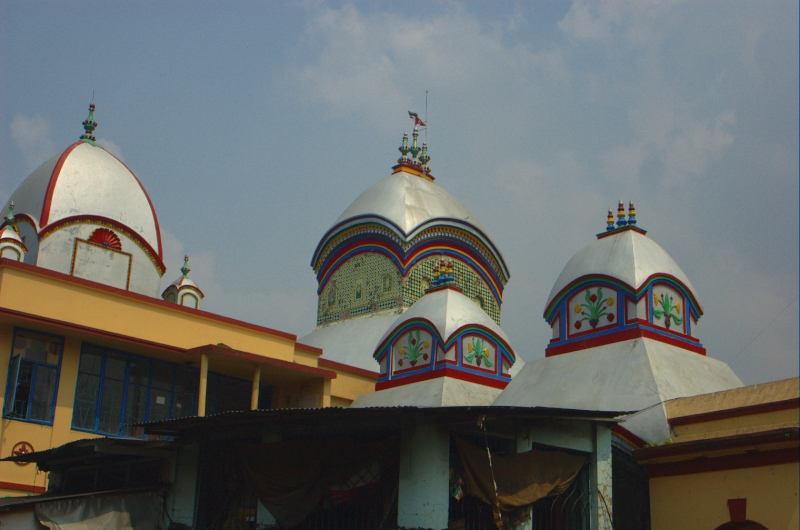
Image Credit: Giridhar Appaji Nag Y, CC BY 2.0 via Wikimedia Commons
https://commons.wikimedia.org/wiki/File:Kalighat_temple_roof.jpg
Jwalaji Temple – Himachal Pradesh
Part Fallen: Tongue
Shakti: Siddhida
Bhairava: Unmatta Bhairava
Set amidst the hills of Kangra Valley, the Jwalaji Temple stands out for one extraordinary reason — a continuously burning flame that emerges naturally from rock crevices, believed to be the tongue of Sati.
The temple has no idol. The eternal flame itself is the deity. Scientists have failed to explain the natural gas source, adding to the temple’s mystique.
📌 Spiritual Highlight: Symbolizes the undying presence of Shakti and the Goddess’s ability to speak, inspire, and guide even without form.
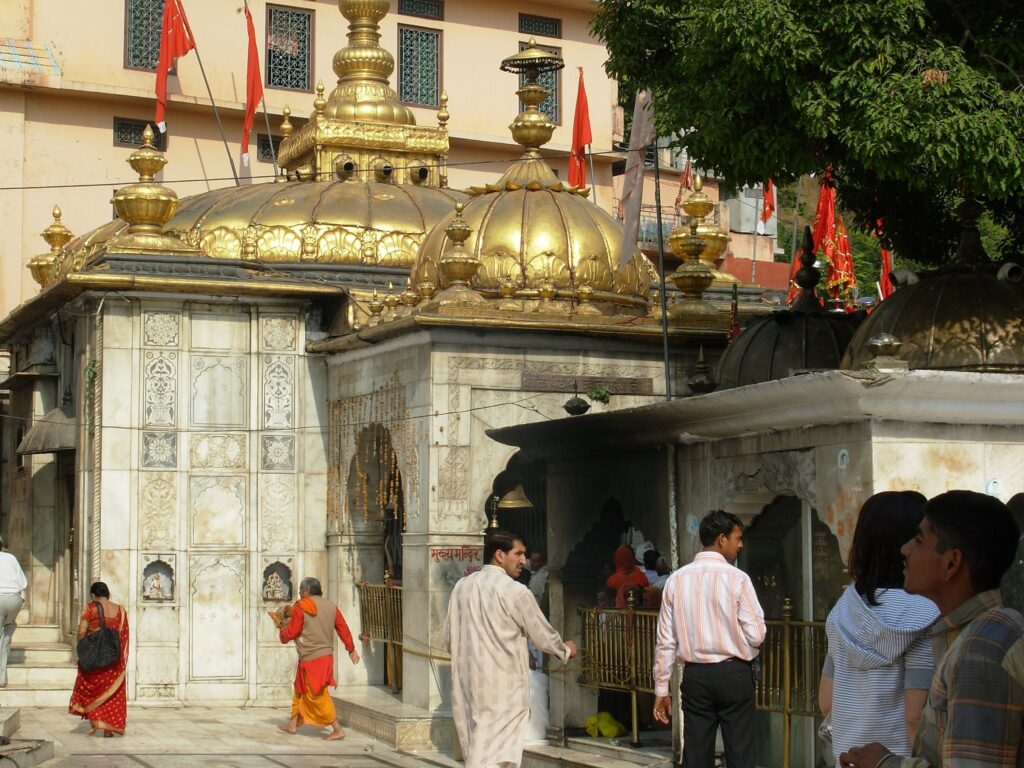
Image Credit: Nswn03, CC BY-SA 3.0 via Wikimedia Commons https://commons.wikimedia.org/wiki/File:Jwalamukhi_temple,kangra,_himachal_pradesh..JPG
Vaishno Devi – Jammu & Kashmir
Part Fallen: Skull (Disputed)
Shakti: Vaishnavi
Bhairava: Bhairon Nath
Though not officially listed in some Shakti Peetha lists, Vaishno Devi is widely considered a part of the Shakti circuit by devotees.
The temple is located in a cave nestled within the Trikuta Mountains, where the Goddess is worshipped in the form of three pindis representing Maha Kali, Maha Lakshmi, and Maha Saraswati.
📌 Spiritual Highlight: A site of unwavering faith; one of the most visited shrines in the world.

Image Credit: Sahusuman, CC BY-SA 4.0 via Wikimedia Commons
https://commons.wikimedia.org/wiki/File:Vaishno_Devi_2.jpg
Guhyeshwari Temple – Kathmandu, Nepal
Part Fallen: Hips
Shakti: Mahashira
Bhairava: Kapali
Close to the famous Pashupatinath Temple, Guhyeshwari is a tantric Shakti Peeth, venerated by both Hindus and Buddhists. The name means “Goddess of the Secret Caves,” reflecting her hidden, mystical nature.
📌 Spiritual Highlight: Known for deep meditation, tantra, and the connection between divine masculine and feminine energies.
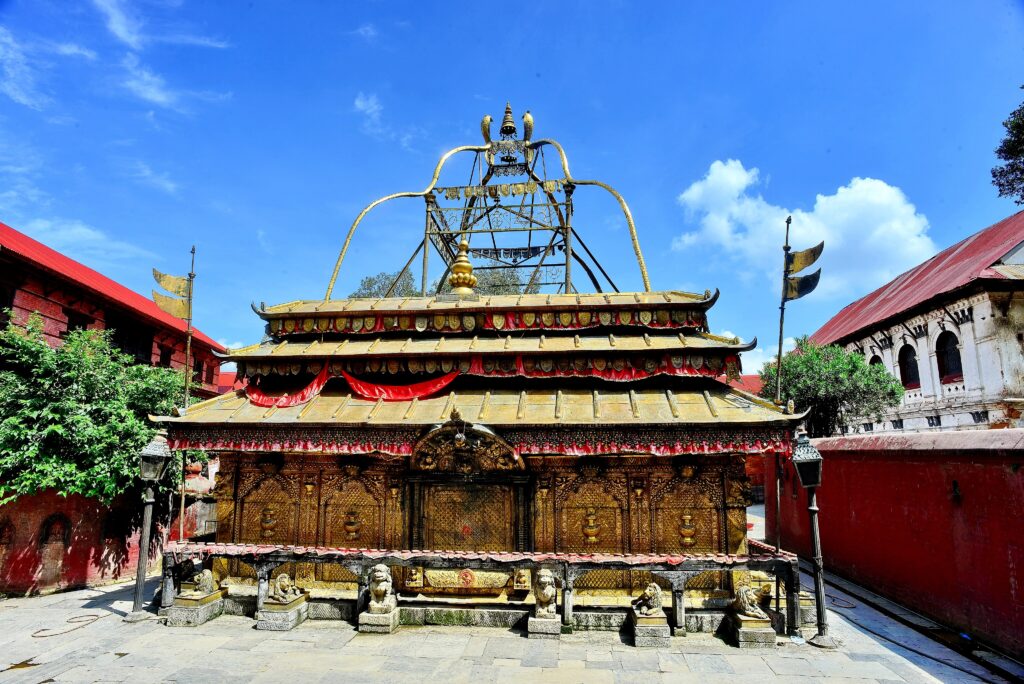
Image Credit: Rajesh Dhungana, CC BY-SA 4.0 via Wikimedia Commons https://commons.wikimedia.org/wiki/
File:Guhyeshwari_Temple_Pashupatinath_Kathmandu_Nepal_Rajesh_Dhungana_(11).jpg
Tripura Sundari – Udaipur, Tripura
Part Fallen: Right Foot
Shakti: Tripura Sundari
Bhairava: Tripuresh
Revered as one of the 18 Maha Shakti Peethas, this temple houses a beautifully decorated idol of the Goddess seated on a throne made of skulls (Charnel Throne). She is worshipped as the goddess of supreme beauty and cosmic wisdom.
📌 Spiritual Highlight: Represents the beauty and intelligence of the divine feminine. The temple is shaped like a Sri Yantra.
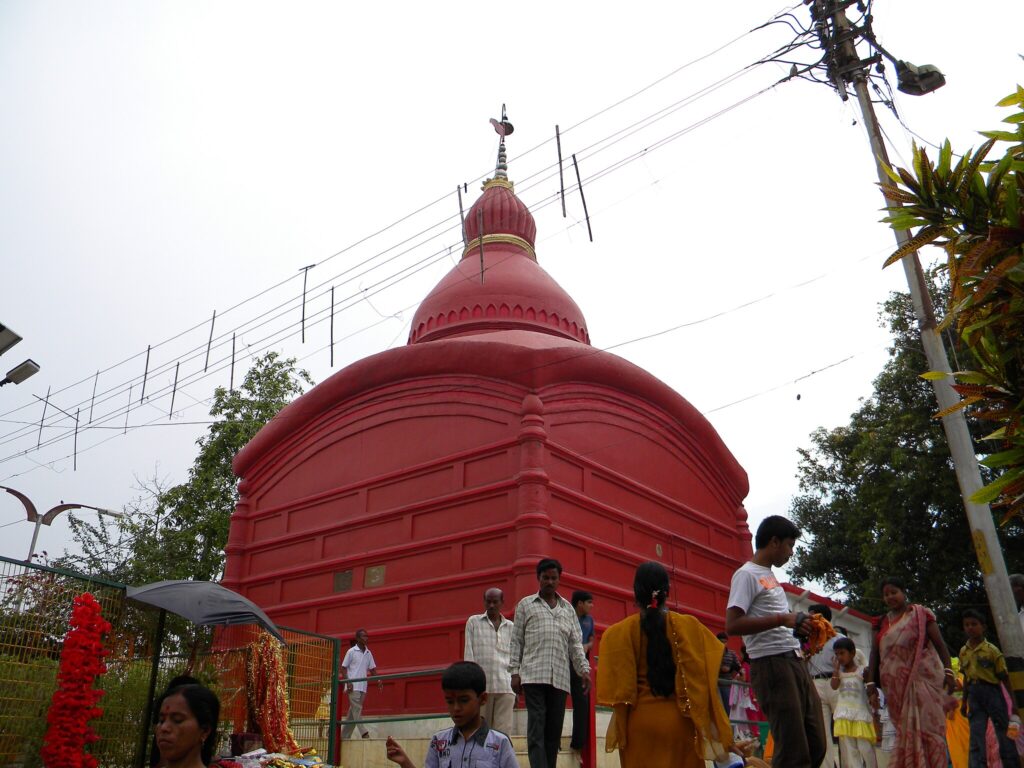
Image Credit: Bodhisattwa, CC BY-SA 4.0 via Wikimedia Commons
https://commons.wikimedia.org/wiki/File:Tripura_Sundari_Temple.JPG
Each Shakti Peeth carries the vibration of a specific part of the Goddess, which in turn corresponds to an aspect of our inner self—power, speech, love, wisdom, or transformation. Visiting them isn’t just a religious act; it’s a journey into your own divine nature.
Shakti Peethas Beyond India: Sacred Sites Across Borders
While most Shakti Peethas are in India, several sacred sites are located in present-day Pakistan, Bangladesh, Nepal, and Sri Lanka. These temples continue to attract pilgrims despite political borders, reminding us that faith transcends geography.
Here are some of the most notable foreign Shakti Peethas:
Hinglaj Mata – Balochistan, Pakistan
- Part Fallen: Bramharandhra (top of head)
- Significance: Hinglaj is one of the four Adi Shakti Peethas and is located in a remote cave in the Hingol National Park.
- Every year, thousands of Hindu pilgrims, especially from Sindh and Balochistan, trek through the desert to pay homage.
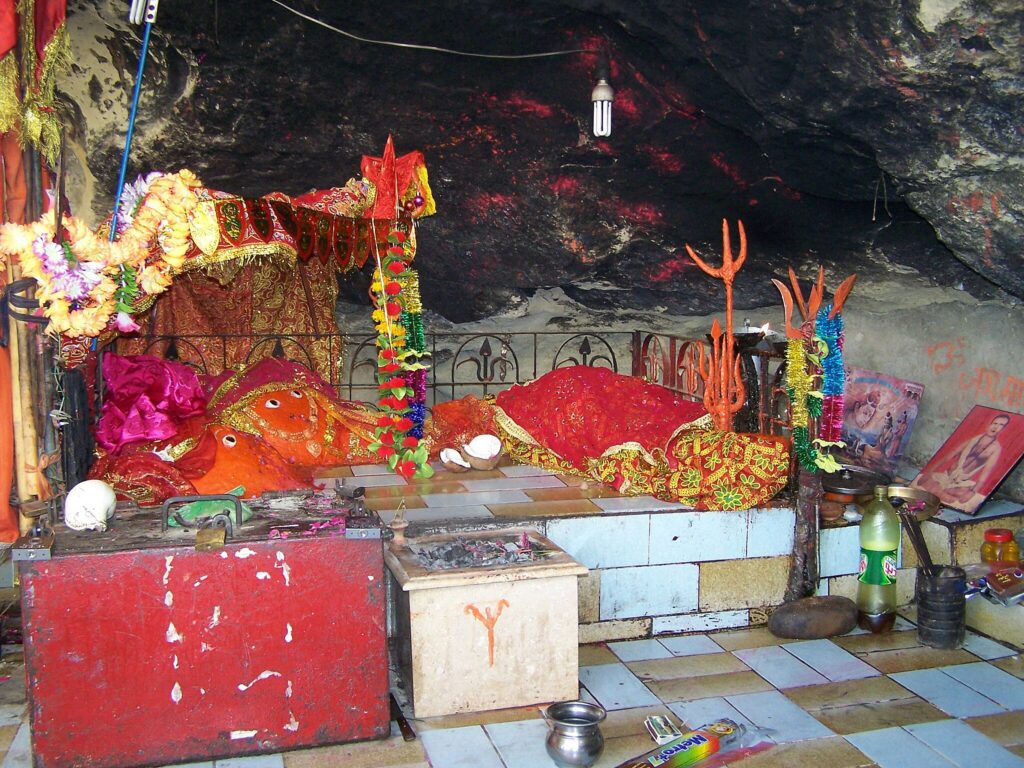
Image Credit: Billmirza at English Wikipedia, CC BY-SA 3.0 via Wikimedia Commons https://commons.wikimedia.org/wiki/File:Nani_ki_Mandir2.jpg
Sugandha Shakti Peeth – Bangladesh
- Part Fallen: Nose
- Shakti: Sunanda
- This temple near Barisal is surrounded by beautiful rivers and hosts traditional Bengali-style worship.

Guhyeshwari – Kathmandu, Nepal
- Also featured earlier, this tantric Peeth near Pashupatinath Temple is worshipped by Hindus and Vajrayana Buddhists alike.
Nainativu (Manipallavam) – Sri Lanka
- Part Fallen: Anklet
- Shakti: Indrakshi
- Located on a serene island, this temple is a hidden gem among international Peethas.
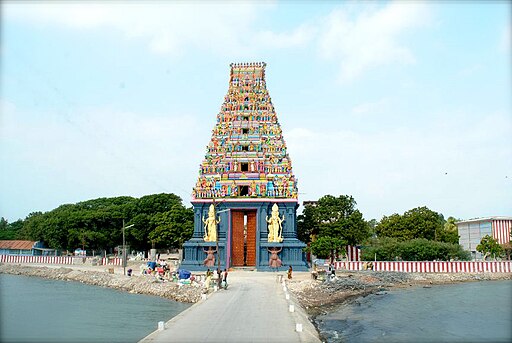
Image Credit: Wikinamaste, CC BY-SA 3.0 via Wikimedia Commons
https://commons.wikimedia.org/wiki/File:Nainativu_Gopuram.jpg
✨ These foreign Peethas show the global nature of Shakti worship, and how ancient spiritual energy maps are still alive in the hearts of devotees, regardless of modern-day borders.
Spiritual Symbolism of the Shakti Peethas
The Shakti Peethas are not just old temples — they are places filled with powerful energy. They represent Shakti, the divine feminine force that gives life to the entire universe.
In Hindu belief, Shakti is the energy that creates and moves everything. She is strength, love, creation, and transformation. The Shakti Peethas are the places where different parts of Goddess Sati’s body are said to have fallen. Each site holds the energy of that body part — like the heart, eyes, tongue, or feet — and connects to a special power within us.
Shakti: The Feminine Cosmic Energy
In Hindu belief, Shakti is the original energy that creates everything in the universe. She is the power that brings things to life and keeps them moving. If Shiva is stillness and awareness, then Shakti is the action, energy, and life force that flows through everything.
Each Shakti Peeth is believed to hold a part of this divine feminine energy, because a part of Goddess Sati’s body fell there. That’s what makes each site sacred.
Whether it’s her heart, eyes, feet, or voice, each part carries a special energy that connects to something within us — like love, vision, stability, or self-expression. So, visiting these places isn’t just about seeing a temple — it’s about connecting to a deeper part of your own spirit.
💡 Symbolically, visiting a Shakti Peetha is not just a physical journey — it is a call to awaken that specific divine quality within yourself.
Bhairava: The Divine Guardian of Energy
At every Shakti Peetha, there is also a temple or shrine for Bhairava, a fierce and protective form of Lord Shiva. If Shakti is pure energy and power, then Bhairava is the one who holds, guides, and protects that energy.
In yogic philosophy, Bhairava stands for:
- Awareness
- Stillness
- Detachment
- The grounding masculine to Shakti’s dynamic feminine
Together, Shakti and Bhairava show us the perfect balance of opposites — like Yin and Yang, Ida and Pingala, or movement and stillness. This unity of energies at each Shakti Peeth is a core idea in both tantra and yoga, reminding us that true power comes from balance and harmony.
Importance in Tantra, Yoga & Kundalini
Many Shakti Peethas are not just temples — they are also ancient centers of Tantra, especially places like Kamakhya, Jwalaji, and Guhyeshwari. In Tantric practice, the Goddess is not only worshipped — she is experienced directly through special rituals, breathing techniques, and deep meditation.
In the language of yoga:
- Shakti is the same as Kundalini — the coiled energy at the base of the spine
- As this energy rises, it moves through the chakras, or energy centers, in the body
- Visiting the Shakti Peethas is like going on an inner journey, helping this energy move upward and awaken your spirit
For example, the temple at Kamakhya, which represents the yoni (womb) of the Goddess, is deeply connected to the Muladhara chakra — the root chakra, or the starting point of spiritual growth.
In this way, the Shakti Peethas are not just holy places outside us — they are also symbols of the sacred power within us, helping us understand and connect with our inner spiritual body.otees to connect body, mind, and spirit.
Why Do Devotees Perform Yatras or Parikramas?
A yatra (pilgrimage) to the Shakti Peethas is more than just visiting temples — it’s a journey that brings inner change and spiritual growth.
As devotees walk, travel, and search for the Goddess, their physical journey reflects an inner journey of devotion. The effort and challenges along the way help build faith, patience, and strength.
Doing a parikrama (walking in a circle around the temple) is also symbolic — it means you’re moving around the center of divine truth, keeping the Goddess at the heart of your life.
Every step taken during the yatra is believed to cleanse the mind, reduce ego, and bring the devotee closer to the energy of the Goddess.
Many also perform Shakti circuits (like the 18 Maha Peeth Yatra or Adi Shakti Peetha Yatra) during Navratri, Durga Puja, or major eclipses, when the energy is believed to be most potent.
✨ In essence, each Shakti Peetha is a living mantra, a sacred sound turned into form. By visiting them—or even meditating on their story—we align with the eternal dance of energy and consciousness.
Modern-Day Pilgrimage: Walking the Path of the Goddess
How Pilgrims Access the Shakti Peethas Today
Today, it’s much easier to visit the Shakti Peethas than it was in the past. Thanks to good roads, trains, and flights, many of these ancient temples can now be reached within a few hours. During big festivals, tourism departments and spiritual travel groups help organize special pilgrimage routes.
Some famous Peethas like Kamakhya and Kalighat even offer online darshan and donation options. This means that even people who can’t travel can still pray and connect with the Goddess from home.
Devotee Experiences: More Than Just a Journey
Even with all the modern facilities, visiting a Shakti Peetha is still a very emotional and spiritual experience. Many devotees say they feel a deep sense of peace, energy, or understanding after their visit. Some even have dreams, visions, or start crying without knowing why.
People believe that the Goddess calls each person when the time is right. And when she does, the journey feels truly special and life-changing.
Navratri & Other Festivals at the Shakti Peethas
Festivals like Navratri, Durga Puja, Ambubachi Mela, and Chaitra Navratri are closely connected to the worship of Goddess Shakti. During these times, temples are beautifully decorated with flowers and lights, and the air is filled with chants, prayers, and songs. Thousands of devotees come together to celebrate and offer their devotion.
Navratri, which means “nine nights,” is one of the most important festivals. Many people go on a Shakti Yatra during this time — visiting different Shakti Peethas or performing special pujas at home to honor the various forms of the Goddess like Durga, Kali, Lakshmi, and Saraswati.
Women and Their Role in Shakti Traditions
Shakti worship is all about honoring feminine power, so it’s no surprise that women play an important role in keeping these traditions alive and growing. They lead rituals, share stories of the Goddess, and pass down old songs and prayers that have been in families for generations.
In villages, women often do daily pujas at small shrines, teach their daughters how to pray, and take charge during festivals like Navratri. In cities, more and more women are becoming spiritual leaders, active devotees, and supporters of temples, proudly reconnecting with the divine as they take on leadership roles in worship.
Conclusion: The Eternal Presence of the Goddess
The Shakti Peethas are not just places on a map — they are full of life and energy. These sacred sites carry the power of the divine feminine, touching the hearts of millions even today. Each temple has its own story — stories of love, loss, strength, protection, and awakening.
From the flames of Jwalaji to the quiet cave of Hinglaj, from the busy streets of Kalighat to the peaceful hills of Kamakhya, the Goddess shows herself in many ways — sometimes strong and fierce, sometimes gentle and kind. Though her body may have been scattered across the land, her shakti (spiritual power) remains whole. It reminds us that the divine is not just outside, but also within us.
In today’s busy world, these powerful places help us slow down, reflect, and reconnect with our inner strength and faith. Whether you travel to the temples or just meditate on their stories, the Shakti Peethas guide those who seek the Goddess within.
As more women step into spiritual roles, as old traditions meet modern journeys, and as belief crosses all borders, the Shakti Peethas continue to shine as symbols of divine energy, balance, and everlasting hope.
🌸 Wherever you are, if your heart is open, the Goddess will find her way to you.
